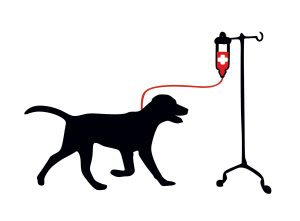 Occasionally during an emergency or for a serious illness a dog may require a lifesaving blood transfusion. This is most commonly needed due to internal organ bleeding caused by trauma, from ingesting a toxin, particularly rat baits or illnesses like anaemia.
Occasionally during an emergency or for a serious illness a dog may require a lifesaving blood transfusion. This is most commonly needed due to internal organ bleeding caused by trauma, from ingesting a toxin, particularly rat baits or illnesses like anaemia.
Some veterinary clinics have their own canine blood bank set up with stores of blood on hand for these situations. Other veterinary clinics may have a list of potential blood donor candidates that they can call on to give blood in the case of emergency. Like humans, dog’s do have different blood types and can even have more than one blood type in their system. Cross matching of blood type between donor and recipient will be undertaken before giving a transfusion.
The process of taking the blood is usually fairly simple and can be done on most dog’s without sedating them. The process involves very little discomfort but the dog will be required to sit still and calm for up to 15 minuets while the blood is being drawn. An ideal blood donor dog needs to be in good overall health, fully vaccinated and free from any internal and external parasites. Young dogs aged 1-7 and larger dogs over 25kg are preferred. The dog also needs to be of a happy and friendly disposition that enjoys visiting the vets and is easy to deal with. Dogs will only be able to donate blood once every 3-6 months to avoid any complications such as anaemia from developing.
One canine unit of blood, which is 450ml, will be drawn from the vein in the neck or the foreleg. One blood donation can potentially save up to three lives with each donation being able to be separated into plasma and red blood cells and used as required either fresh or refrigerated.
If you think your dog would be a suitable blood donor get in touch with your local veterinary clinics or animal hospitals and let them know that your canine friend is available to help save a life.
Until next time,
Bec
